#Mammal facts
Text
Critter fact #107:
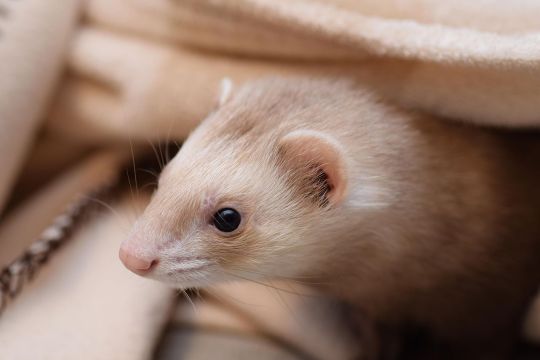
Ferrets (Mustela furo) are descended from polecats.
37 notes
·
View notes
Note
hi would you like to perhaps trade modern animal facts for dinosaur facts.........
WOULD I????
Did you know cats have whiskers on their feet it's right up near their topmost toe it helps them figure out where to pounce when hunting
Shrews are cool as FUCK so because they are so small they need to have a very high metabolism- small body = loses heat faster some of them are as small as almonds!!! they are incredibly powerful hunters and can hold a territory that can be up to over 600 yards!!!! they have to eat a LOT to keep up with their high metabolism so when they hunt they will kill something and leave it there if they manage to catch something else before they finish eating and only once they no longer have any prey to catch will they eat their stockpile, the bodies of their kills are usually stacked up together. Shrews also have super fast heart and breath rates they lose heat super fast and their heart can be up to 800 bpm and their breath up to 500/minute Shrews live in high altitude and climates so how are they keeping their body warm? they use the snow as an insulater! they'll burrow under the snow and use it as a way to keep the heat inside their tunnels. when a shrew is pregnant they will eat a lot more a 7lb shrew will eat 8lbs of food for example- and their milk can shift through lactation for nutrition (colostrum and weaning milk for example)
speaking of reproduction- just like bees male mouse opossums will die right after mating- as they reach their sexual maturity they will go into overdrive they won't eat and have a very high stress level males of this species very rarely survive more than a year
you might know that all animals (aside from primates/humans) have an extra layer in the back of their eye called the tapetum lucidum, this is what eye shine is ot helps soak in light when in the dark
speaking of vision teehee
only primates have trichromatic vision most mammals only have dichromatic vision where they lack the cone rods to see green/yellow colors
ok so hearing right? so most animals other than us have pinna which makes it so their ears can move towards sound but mammals also hear different frequencies like I'm sure you've heard about how cats talk to their kittens in a different way than older cats? humans do that too! when we use baby talk for pets or children but some animals speak out of our frequencies entirely for example mice will sing to each other to find mates!
OK more specific animal facts- beavers are SICK ok so their skulls look like this
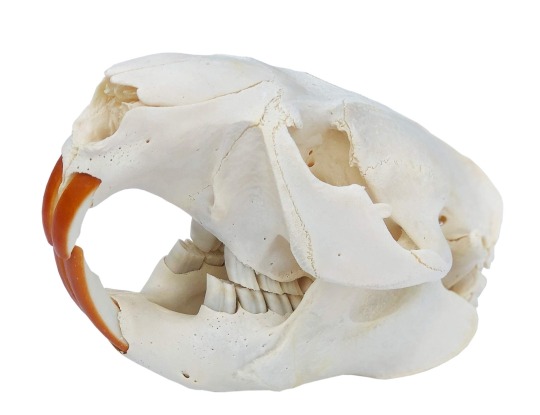
see that giant open space behind their front teeth? they use that space to suck in their cheeks to create a blockage and make sure they don't get wood chips down their throat when chomping on trees for their dams
bats have little tiny bumps on their wings for wind turbulence
some fish have electroreception which is when you can sense electric currents by other organisms with like open channels on their cells but so can MOLES!!!
baby cheetas are born with extra fur and slightly different markings to look more like Hyena pups so that they are less likely to be attacked by them
speed round- farm edition (because I was an animal educator at a farm for years)
goats are immune to poison ivy and you can still drink their milk after
horses only breathe through their nose they can't breathe from their mouths
domestic sheep HAVE to be sheared every year as they will just continue to grow wool forever and ever until death
llamas are super clean animals a llama herd will designate one specific area for pooping they're also super good guard animals and are used to kill foxes going after chickens sometimes
emus can run 31mph (the one I worked with named Mu was also mean as hell but they can be super sweet)
bunnies sleep with their eyes open as they are prey animals they also will almost always poop as they are eating and must be eating or at least offered food nearly 24/7 or they will die similar to a shrew
goat horns are connected directly to their skulls and they LOVE when you scratch in-between them for them :)
most animals have a baculum (penis bone) except us and herbivores [that was an adult group fact not a children group fact]
I'll leave it there for now but I always have more >:)
#animal facts#special interest#zoology#animals#word dump#shrew#emu#beaver#goat#bunnies#llamas#I actually used to train llamas#bats#mammalogy#mammal facts#i dont know much about reptiles or birds (yet)#cat#dog#mouse#mice#primates#humans#sorta#mole#cheeta#horse#sheep#baculum#science#animal science
36 notes
·
View notes
Text
Hey people! I'm so sorry for being inactive for AGES
It feels like my acc has lost its purpose, but I'll try and make sure I post content on a regular basis that keeps y'all entertained :)
And mostly, tysm to all my new followers, and i hope y'all love my acc ^^
Fact of the day:
Sloths have more neck bones than giraffes!
Despite the difference in neck length, there are more bones in the neck of a sloth than a giraffe. There are seven vertebrae in the neck of a giraffe, and in most mammals, but there are ten in a sloth’s.
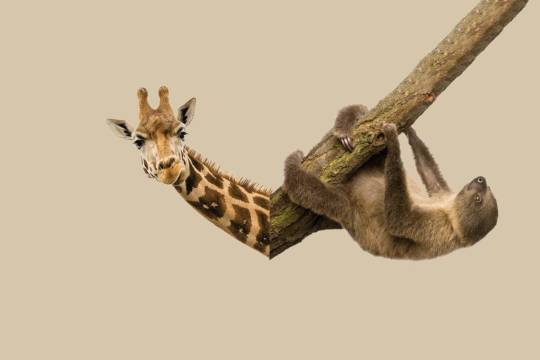
#interesting facts#factsonly#fun facts#fact of the day#amazing facts#facts#factoftheday#trivia#miscellaneous facts#random facts#i love animals so much#animal facts#sloth#giraffe#mammal facts#mammal#animal trivia#cute animals#animals#animal planet#lovely animals
9 notes
·
View notes
Text
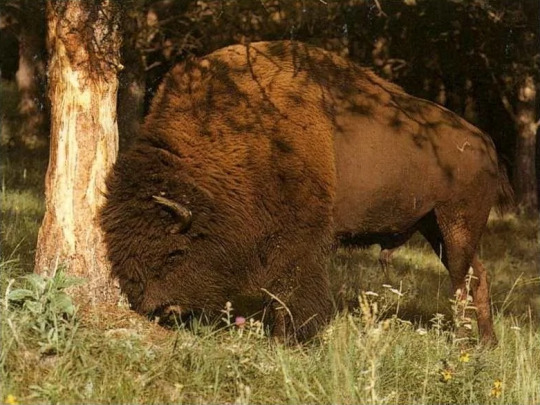
American bison
By: Unknown photographer
From: Wildlife Fact-File
1990s
3K notes
·
View notes
Text
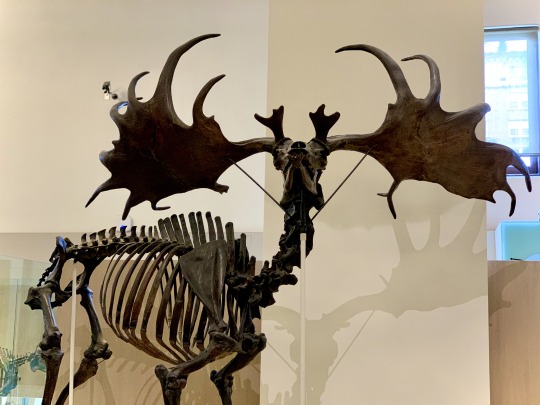
We’re celebrating Saint Patrick’s Day in a big way, with one of the largest known deer: the Irish Elk (Megaloceros giganteus)! It was originally discovered in bog deposits in Ireland. This megafauna could weigh up to 1,500 pounds (680 kg) and its antlers could reach an incredible 13-ft- (4-m-) spread. Once ranging from western Europe to China, this animal died out some 10,000 years ago. However, at least one population, living in Russia’s Ural Mountains, managed to survive until about 7,770 years ago, long after the end of the Pleistocene.
See the Irish Elk up close in the Museum’s Hall of Advanced Mammals! We’re open daily from 10 am-5:30 pm. Plan your visit.
Photo: © AMNH
#science#amnh#museum#fossil#natural history#nature#paleontology#megafauna#did you know#fact of the day#fun fact#saint patricks day#st patricks day#luck of the irish#deer#mammals
2K notes
·
View notes
Text




In a 2 week long polling tournament, the “Ultimate Feliform” was voted on in my Instagram stories.
So here are some fun facts about the teeny tiny termite-eating hyena who was deemed champion: the aardwolf!
3K notes
·
View notes
Text
For today's pride month post, let's talk about white tailed deer!

Now these guys actually surprised me, did you know up to 15% of white tailed deer are intersex? There are deer that are born with both sex organs, females that grow antlers, and even what's known as Velvethorns.

A normal buck will shed it's velvet from late August to early September, but velvet horns never she'd their velvet. As a buck's testosterone level rises as they get ready for mating season their antler's harden and their velvet is shed.
So why doesn't this happen to velvet horns?
Depending on the reason, be it birth defect, or some sort of truama to the testicles, these guys just never get that testosterone boost. It also leads to them having an appearance more similar to a doe than a buck.
They tend to shy away from male or female groups, instead forming herds with other velvet horns, they've even been known to adopt orphaned fawns!

Even the hunting community knows about these deer, some states actually having them tag the deer as "antlered" or "antlerless" to avoid any confusion!
#i was using this as an excuse to post more of my own cam footage😅#animals#trail cam#mammals#nature#critters#wild life#wildlife#animal facts#facts#pride#deer#white tailed deer#lgbtq#lgbt#intersex#pride month
2K notes
·
View notes
Text
Wet Beast Wednesday: walrus
There are a lot of iconic arctic animals, such as the polar bear and narwhal, but my personal favorite is the walrus. Known for their large tusks, prominent whiskers, and habit for busting myths creepy eyes, walruses are unique amongst the pinnipeds. Most people know of the two main groups of pinnipeds: Phocidae, the earless or true seals and Otariidae, the fur seals and sea lions. Walruses however are in a class of their own, being the only surviving species of their own family: Odobenidae. A weird fact that I learned researching for this is that taxonoimists used to think Odobenids evolved from bears before later reclassifying them alongside the other pinnipeds. Old-timey taxonomy was wild and came up with some absolutely unhinged ideas. Like they used to think that microbats and megabats weren't related, instead classifying megabats as primates.

(image; a walrus sitting on an ice flow. It is a large, brown mammals with short limbs that end in flippers. Its head has a wide, blunt snout and two long tusks emerging from the upper jaw)
There is one species of walrus, Odobenus rosmarus, divided into two subspecies based on location: the Atlantic walrus (O. r. rosmarus) and Pacific walrus (O. r. divergens). The two subspecies are still very similar and genetic testing indicates they diverged between 750,000 and 500,000 years ago. There used to be a third listed subspecies from the Laptev sea, O. r. laptevi, but they have since been reclassified as a population of the Pacific walrus. Walruses are very large, being the third largest pinnipeds after the two elephant seal species. The Pacific subspecies is larger than their Atlantic brethren with most males reaching an average weight between 800 and 1,700 kg (1,800 to 3,700 lbs). A few males have been known to grow considerably larger than average. Male Atlantic walruses average about 900 kg (2,200 lbs). In both subspecies, females are about 2/3 the size of males and have shorter tusks. a large portion of their weight comes from the thick layer of blubber under their skin that helps them stay warm. Both subspecies have an average length between 2.2 and 3.6 meters (7.4 to 11.8 ft). Walruses have hind flippers that can turn forward to act like feet, letting them crawl on all fours like sea lions. Like true seals, they have no external ears. The skin is very thick and mostly bald. They are born with brown skin that becomes lighter as they age. While swimming, the blood vessels in the skin construct to reduce blood flow and limit heat loss, which makes them considerably lighter, almost white. Males have skin nodules called bossed around the neck and shoulders. Their creepy eyes are the result of eye sockets with no roof and powerful extraocular muscles that let the eyes protrude out of the skull and look both forward and sideways. The famous mustaches are composed of 400-700 thick whiskers. The whiskers are attached to muscles and have both nerve ending and blood supply. They are incredibly sensitive sense organs and a walrus can identify objects as small as 2mm with its whiskers. Their lips are muscular and flexible and aid in creating a large variety of noises.

(image: a close-up of a walrus's face, showing its prominent whiskers and small eyes. Its mouth is open, revealing its tongue)
youtube
How come the walrus can whistle but I can't? (video: a walrus in a zoo being instructed by its handler to make multiple vocalizations)
Of course the most famous features of walruses are their tusks. These two large canines can reach a meter in length and are larger in males than females. The tusks have a number of uses in both sexes, though males use them more. In both sexes, they are used to help dig breathing holes in sea ice, hang onto ice and help the walrus climb out of the water. Males also use their tusks in displays of dominance, especially during mating season. Larger tusks are a sign of dominance and typically the walrus with the largest tusks will win standoffs. If a standoff escalates from posturing to a fight, they will use their tusks as weapons. They tend to strike around the neck and shoulders and the skin nodules in those areas help protect males from each other's tusks. It was formerly believed that walruses would use their tusks to dig for prey on the sea floor, but this is no longer believed to be the case.

(image: a walrus skull showing the tusks)

(image: a walrus using its tusks to hang onto the ice and keep its nostrils above the water)
Walruses spend a lot of their time searching for the food they need to support a body that big. They prefer forging along the continental shelf and spend much more time in shallow water than other pinnipeds. While walruses have been tracked diving 500 meters deep, the majority of dives are much more shallow. The vast majority of a walrus's diet consists of seafloor-dwelling invertebrates including tubeworms, soft corals, tunicates, crabs and shrimp, sea cucumbers, and mollusks. While that's a wide palette, their absolute favorite food is clams. To hunt, walruses drag their noses and the forward surface of their tusks through the sediment and use their whiskers to search for food. This stirs up the sediment and releases nutrients back into the water column, a process balled bioturbation. Many foods can be swallowed whole or chewed, but they have a special feeding style for clams and other bivalves. Walruses will hold the bivalve in their mouths and use their flexible lips to form a water-tight seal around it. It then withdraws its tongue into its mouth to create enough suction to suck the bivalve meat right out of the shell. So important is this strategy to feeding that the shape of their mouths is specially adapted to it. Walruses are also known to feed on seals, though how much of that is due to hunting or scavenging is unknown. Additionally, they will scavenge whales, may hunt walrus trapped under sea ice, and have been seen catching and eating birds.
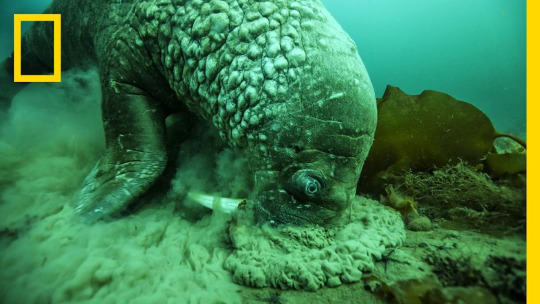
(image: a walrus foraging for food underwater. It has its snout pressed into the sea floor and is kicking up a large amount of sediment. Still from a National Geographic video)
Walruses are social and migratory, traveling south for the winter and north for the summer in aggregations that can be tens of thousands strong. They will haul out onto land or sea ice in huge numbers, blanketing the landscape in blubber and tusks. While these aggregations are preferred, they are not considered a true social species as they do not aid each other when together. Walruses on land or ice are skittish and will spook easily. Being startled can lead to stampedes while the walruses flee back to sea. Sometimes, walruses will be trampled to death during these stampedes. During mating season, the normally cordial walruses become much less friendly to their neighbors. Breeding seasons lasts from January to March. During this time, males will gather in the water around females in heat and compete for the change to get to that nice walrussy (I will not apologize). This is usually done via bellowing and posturing with the tusks, but may escalate to fights. While males become sexually mature around age 7, they often do not become large and strong enough to secure mates until around age 15. Females become sexually mature between 4 and 6 years old. Curiously, females enter heat twice per year, but males are only fertile once per year. Gestation takes up to 16 months and calves are born able to swim and weighing up to 75 kg (165 lbs). Females with calves move away from the large aggregations, possibly to keep their calves from being crushed in stampedes and possibly to make it harder for predators to detect their scent. Nursing lasts for over a year, longer than in many pinnipeds. Walrus milk is fattier than that of land mammals, but less fatty than that of true seals, forcing walrus mother to nurse longer. Even after being weaned, walruses may spend up to 5 years with their mothers. Females only mate at most every two years, which gives the walrus the lowest reproduction rate of all pinnipeds. Walruses can live up to 30 years in the wild and 40 years in captivity. Male walruses have the largest penis bone of any non-cetacean both in absolute size and proportionately.
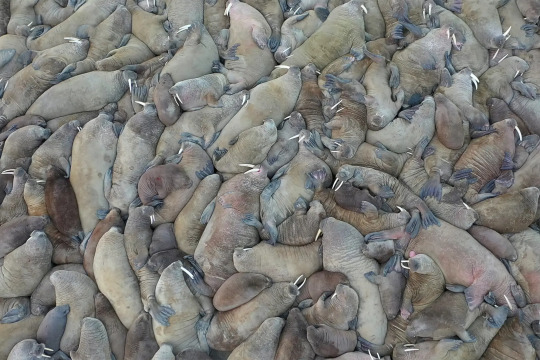
(image an aerial shot of a walrus herd on land. There are many walruses and they are so tightly packed together that no ground is visible)

"Don't talk to me or my son ever again" (image: a mother walrus with its calf. The calf is a smaller version of the mother with no tusks. The calf is sittting by its mother's side. Both are looking at the camers)
Walruses have been hunted by humans living in the arctic circle for millennia. Hunting peaked in 18th and 19th centuries when there was a high commercial demand for meat, blubber, skin, and ivory. This almost led to the extirpation of Atlantic walruses. Since then, hunting has been outlawed except by indigenous peoples, allowing the populations to recover. Now, the major threat to walruses is climate change leading to loss of sea ice needed for hauling out and breeding. The IUCN lists both subspecies as Vulnerable. They were an important source of food and other materials to the peoples of the arctic circle and appear frequently in the mythology of said peoples.

(image: a walrus tusk carved with the images of multiple fish, seals, and polar bears)
#wet beast wednesday#walrus#pinniped#marine biology#zoology#ecology#marine mammals#animal facts#biology#Youtube
503 notes
·
View notes
Text
Uncharismatic Fact of the Day
For the Palestine mole rat, which lives almost entirely underground, finding other members of their species. Fortunately, this species has a special way of attracting potential mates: when the breeding season starts, males and females drum their heads against the roof of their tunnels. This sends vibrations through the ground that lets other mole rats know exactly where they are.
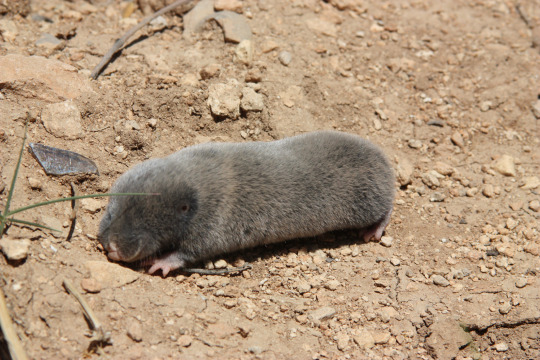
(Image: A Palestine mole rat (Nannospalax ehrenbergi) by Zuhair Amr et al.)
If you send me proof that you’ve made a donation to UNRWA or another organization benefiting Palestinians, I’ll make art of any animal of your choosing.
Remember, the donation can be in any amount-- every dollar counts!
#palestine mole rat#free palestine#Rodentia#Spalacidae#small-bodied mole rats#spalacids#mole rats#rodents#mammals#uncharismatic facts
384 notes
·
View notes
Video
You can feel the power of a Bull Hippo just watching this, the most dangerous mammal in the world.

They aren’t fat at all, that’s all pure muscle! They cannot float, they just run along the bottom of the water!
#animals#nature#videos#scary#hippopotamus#hippos#animal facts#natural history#hippo#ungulate#mammal#animal#beasts#video#nature is metal#wildlife
3K notes
·
View notes
Text
Wonderful news from the Cyclops Mountains of West Papua today with the rediscovery of Attenborough's long-beaked echidna (Zaglossus attenboroughi)!

(Image credit: Expedition Cyclops)
Previously known a single specimen collected in 1961, Attenborough's long-beaked echidna has long been one of the world's most elusive mammals. Recognised as a distinct species in 1998, an expedition to the Cyclops Mountains in 2007 failed to observe the echidna but found evidence of recent diggings and foraging activity which, alongside local knowledge, implied that the species still survived in those remote mountain forests.
Finally, just a few months ago, a new expedition into its remote mountain home by Expedition Cyclops caught the first ever footage of Attenborough's long-beaked echidna in the wild, which is also the first time it has been seen by scientists in over 60 years. In a remarkable stroke of luck, the echidna was captured on the last of over 80 camera traps on the final day of the trip!
Attenborough's long-beaked echidna is the most distinctive of the three species of long-beaked echidna thanks to its smaller size, shorter, straighter beak and reddish-brown fur. Its habits are virtually unknown, but its differently shaped beak may suggest that it differs in diet and feeding habits from the other two long-beaked echidna species. It appears to be endemic to the highest elevations of the Cyclops Mountains, which are steep, extremely rainy and treacherous to explore, hence why it remained hidden for so long.

(Image credit: Expedition Cyclops)
There are only five species of monotreme alive today, the sole living custodians of a lineage stretching back some 200 million years, and this makes each species extraordinarily valuable. Unfortunately, all three species of long-beaked echidna are threatened with extinction, with Attenborough's long-beaked echidna being classed as critically endangered. Losing any species is a tragedy, but for a group as small and precious as monotremes, any extinction would be especially disastrous.
Alongside the rediscovery of the echidna, Expedition Cyclops also made the first record of Mayr's honeyeater (Ptiloprora mayri) in 16 years and discovered dozens of new species of insects, arachnids, shrimp and frogs. Their work documenting the hidden biodiversity of the Cyclops Mountains is ongoing, so if you'd like to follow and support the expedition make sure to visit their website!
https://www.expeditioncyclops.org/
#oceania#papua#west papua#new guinea#wildlife#mammal#mammals#monotreme#monotremes#echidna#echidnas#animal facts#animal news#mammalogy#natural history#my stuff
288 notes
·
View notes
Text
Critter fact #19:

The Capybara (Hydrochoerus hydrochaeris) is the world's largest rodent. Due to their webbed feet, as well as the position of their ears, eyes, and nostrils (on top of their head), they're great swimmers. July 10th is Capybara Appreciation Day!
44 notes
·
View notes
Text
oooo ok I have an idea for my followers on Tumblr dot com >:) send me an animal- preferably a mammal, and I'll make a whole blog post about cool facts about them
like ok I don't think you guys understand how fun this is for me I fucking LOVE talking about animals if I could watch animal behavior all day every day I would do it in a heartbeat ill even make posts about common animals like dogs and cats throw em at me the weirder the better
#zoology#zoologist#animal facts#animals#special interest#mammals#mammalogy#mammal facts#i know stuff about some birds and reptiles too#i may need to do research on those guys though#but bro researching them is like a little treat#i know things about really exotic creatures too im ready for a challenge#holy fucking shit ask me about animals please oh my god#holy fuck#i also know some plant facts#not as many but i do have some diagnostic traits about around 180 different species and genera in north america#i know a lot about wine too#ask me about plants or animals omfg#plant facts
19 notes
·
View notes
Text
The Colugo: this mammal is able to glide through the air using a fur-covered membrane that stretches across most of its body margin
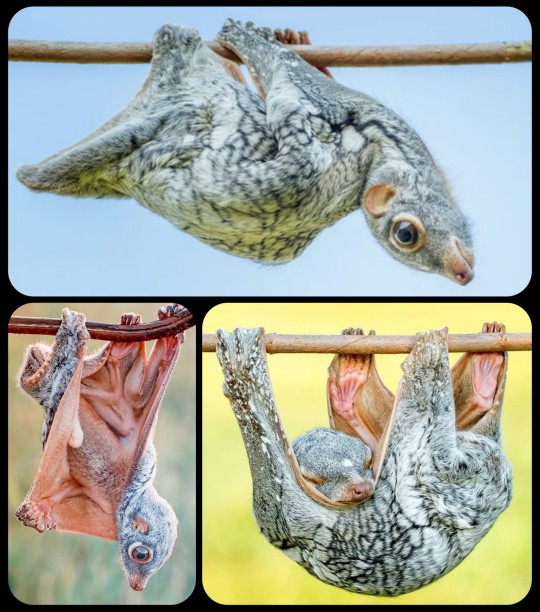
Colugos are often referred to as "flying lemurs," but genetic studies have shown that they are actually among the closest living relatives of primates, occupying a sister group.
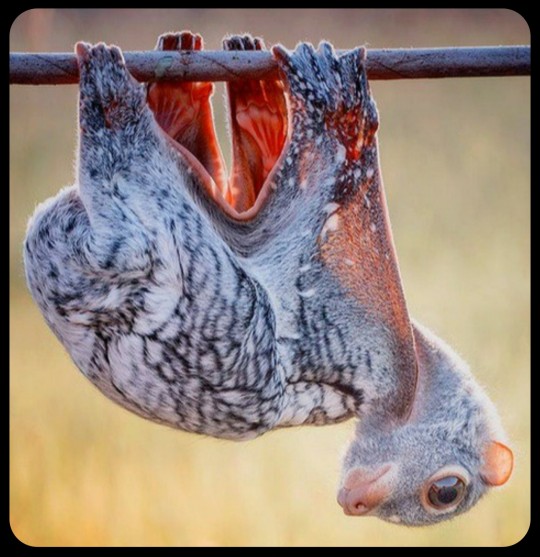
They are native to the tropical rainforests of Southeast Asia, where they are divided into two extant species: the Philippine flying lemur (Cynocephalus volans) can be found in the Southern Philippines, and the Sunda flying lemur (Galeopterus variegatus) can be found in parts of Vietnam, Laos, Cambodia, Thailand, Myanmar, Malaysia, and Indonesia.
The fur-covered membrane that stretches across the colugo's body is known as a patagium; a similar membrane can be found in other gliding mammals (e.g. flying squirrels, sugar gliders, etc.) but the patagium of the colugo is far more extensive, surrounding almost all of the animal's body margin and stretching even between the tail and hind legs.

When they are not actively gliding, female colugos with young offspring will often pull their tails up against their bellies, effectively curling the patagium into a pouch in which the baby can be carried and protected. In order to glide, however, the mother must fully extend her patagium, meaning that she must unfold the pouch; if the baby has not yet learned how to glide on its own, then it must curl itself around the mother's torso and hold on tight as she glides from tree-to-tree.
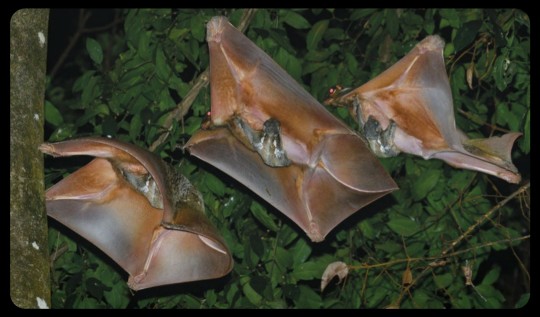
The extensive size of their patagium means that colugos have far more "wing space" than other gliding mammals, which enables them to glide much further. In a single leap, a colugo may glide across a distance of up to 145 meters (about 475 feet) -- nearly the length of three Olympic-sized swimming pools. Studies have shown that they can glide a total distance of 1,342 meters (4,403 ft) per night, climbing a total of 320 meters (1,050 ft) up into the trees in order to do so. They have extremely strong claws, and the soles of their feet are able to mimic suction-cups, which enables them to maintain a tight grip on tree trunks and branches.
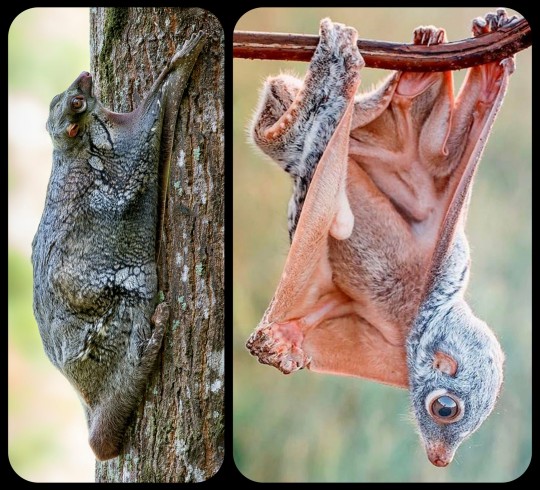
Colugos are most active at night, and they are strictly herbivorous, feeding only on young tree leaves.

I don't normally feature mammals on my blog, but this one in particular seemed too heartbreakingly adorable and too weird for me to ignore. I mean, look at it -- it's like a tiny dinosaur wrapped in a Snuggie!
Sources & More Info:
Science News: On a Cool Night in Malaysia, Scientists Track Mysterious Colugos Across the Treetops
Animal Diversity Web: Galeopterus variegates (the Sunda Flying Lemur)
BioMed Central Journal of Biology: Colugos: obscure mammals glide into the evolutionary limelight
World Wildlife Fund: Flying Lemurs
National Geographic: Why Do Flying Lemurs Glide?
Animal Diversity Web: Cynocephalus volans (the Philippine Flying Lemur)
#mammals#zoology#animals#nature#colugos#sunda#flying lemurs#animal facts#gliders#southeast asia#wildlife#cute animals#cool animals#nature is weird#these guys probably give the very best hugs tho
775 notes
·
View notes
Text
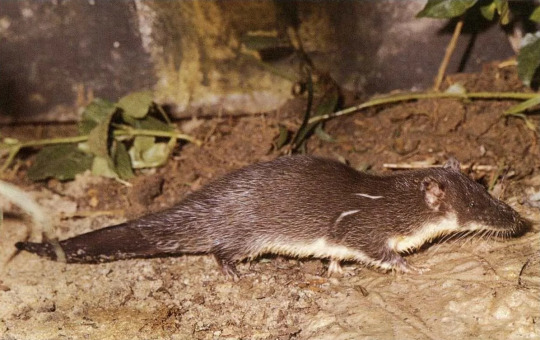
Giant otter shrew
By: Unknown photographer
From: Wildlife Fact-File
1990s
1K notes
·
View notes
Text

🐘 Nothing quite compares like the bond between a mother and her child. Related African elephant (Loxodonta africana) females and their young live in tight-knit families led by a matriarch. This older, female leader helps the group survive by sharing her hard-earned wisdom, like remembering the locations of watering holes in times of drought.
Elephant family groups grow very attached. Mothers are extremely protective of their calves, and younger females act as attentive “babysitters.” These giants show their affection through touch, especially with their trunks, as well as through gesture and sound. Individual elephants remember their feelings for one another even when separated for years. Learn more about these incredible animals in the Museum’s exhibition The Secret World of Elephants.
Photo: Timothy A. Gonsalves, CC BY-SA 4.0, Wikimedia Commons
#nature#natural history#animals#elephants#african elephant#did you know#fact of the day#mothers day#moms#cool animals#animal facts#mammals#happy mothers day
552 notes
·
View notes